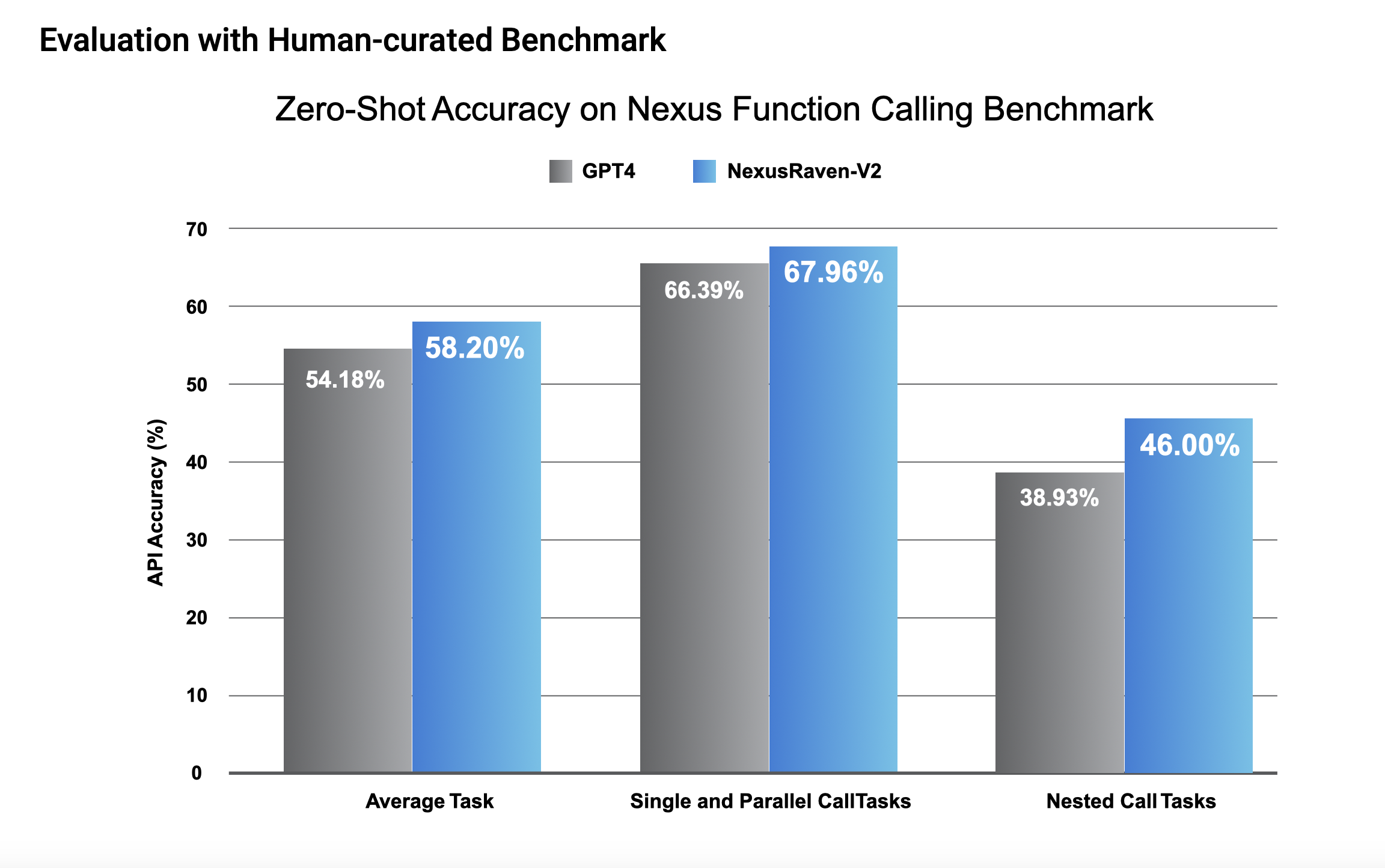license: other
base_model: codellama/CodeLlama-13b-Instruct-hf
model-index:
- name: NexusRaven-13B
results: []
NexusRaven-13B: Surpassing GPT-4 for Zero-shot Function Calling
Nexusflow HF - Nexusflow Discord - NexusRaven-V2 blog post - Prompting Notebook CoLab - Leaderboard - Read-World Demo - NexusRaven-V2-13B Github
Introducing NexusRaven-V2-13B
NexusRaven is an open-source and commercially viable function calling LLM that surpasses the state-of-the-art in function calling capabilities.
💪 Versatile Function Calling Capability: NexusRaven-V2 is capable of generating single function calls, nested calls, and parallel calls in many challenging cases.
🤓 Fully Explainable: NexusRaven-V2 is capable of generating very detailed explanations for the function calls it generates. This behavior can be turned off, to save tokens during inference.
📊 Performance Highlights: NexusRaven-V2 surpasses GPT-4 by 7% in function calling success rates in human-generated use cases involving nested and composite functions.
🔧 Generalization to the Unseen: NexusRaven-V2 has never been trained on the functions used in evaluation.
🔥 Commercially Permissive: The training of NexusRaven-V2 does not involve any data generated by proprietary LLMs such as GPT-4. You have full control of the model when deployed in commercial applications.
Please checkout the following links!
NexusRaven-V2 model usage
NexusRaven-V2 accepts a list of python functions.
These python functions can do anything (including sending GET/POST requests to external APIs!).
The two requirements include the python function signature and the appropriate docstring to generate the function call.
NexusRaven-V2 also does best on functions with arguments, so please always only provide functions that require arguments to raven.
NexusRaven-V2's Capabilities
NexusRaven-V2 is capable of generating deeply nested function calls, parallel function calls, and simple single calls. It can also justify the function calls it generated. If you would like to generate the call only, please set a stop criteria of "<bot_end>". Otherwise, please allow NexusRaven-V2 to run until its stop token (i.e. "</s>").
Quick Start Prompting Guide
Please refer to our notebook, How-To-Prompt.ipynb, for more advanced tutorials on using NexusRaven-V2!
- When giving docstrings to Raven, please provide well-indented, detailed, and well-written docstrings as this can help accuracy.
- Raven does better when all functions provided to it has arguments, either required or optional, (i.e.
func(dummy_arg)is preferred overfunc()) as this can help accuracy. - We strongly recommend to set sampling to False when prompting NexusRaven-V2.
- We strongly recommend a very low temperature (~0.001).
- We strongly recommend following the prompting style below.
When handling irrelevant user queries, users have noticed that specifying a "no-op" function with arguments work best. For example, something like this might work:
def no_relevant_function(user_query : str):
"""
Call this when no other provided function can be called to answer the user query.
Args:
user_query: The user_query that cannot be answered by any other function calls.
"""
Please ensure to provide an argument to this function, as Raven works best on functions with arguments.
Quickstart
You can run the model on a GPU using the following code.
# Please `pip install transformers accelerate`
from transformers import pipeline
pipeline = pipeline(
"text-generation",
model="Nexusflow/NexusRaven-V2-13B",
torch_dtype="auto",
device_map="auto",
)
prompt_template = \
'''
Function:
def get_weather_data(coordinates):
"""
Fetches weather data from the Open-Meteo API for the given latitude and longitude.
Args:
coordinates (tuple): The latitude of the location.
Returns:
float: The current temperature in the coordinates you've asked for
"""
Function:
def get_coordinates_from_city(city_name):
"""
Fetches the latitude and longitude of a given city name using the Maps.co Geocoding API.
Args:
city_name (str): The name of the city.
Returns:
tuple: The latitude and longitude of the city.
"""
User Query: {query}<human_end>
'''
prompt = prompt_template.format(query="What's the weather like in Seattle right now?")
result = pipeline(prompt, max_new_tokens=2048, return_full_text=False, do_sample=False, temperature=0.001)[0]["generated_text"]
print (result)
This should generate the following:
Call: get_weather_data(coordinates=get_coordinates_from_city(city_name='Seattle'))<bot_end>
Thought: The function call `get_weather_data(coordinates=get_coordinates_from_city(city_name='Seattle'))` answers the question "What's the weather like in Seattle right now?" by following these steps:
1. `get_coordinates_from_city(city_name='Seattle')`: This function call fetches the latitude and longitude of the city "Seattle" using the Maps.co Geocoding API.
2. `get_weather_data(coordinates=...)`: This function call fetches the current weather data for the coordinates returned by the previous function call.
Therefore, the function call `get_weather_data(coordinates=get_coordinates_from_city(city_name='Seattle'))` answers the question "What's the weather like in Seattle right now?" by first fetching the coordinates of the city "Seattle" and then fetching the current weather data for those coordinates.
If you would like to prevent the generation of the explanation of the function call (for example, to save on inference tokens), please set a stopping criteria of <bot_end>.
Please follow this prompting template to maximize the performance of RavenV2.
Using with OpenAI FC Schematics
Using With LangChain
We've also included a small demo for using Raven with langchain!
Evaluation
For a deeper dive into the results, please see our Github README.
Limitations
- The model works best when it is connected with a retriever when there are a multitude of functions, as a large number of functions will saturate the context window of this model.
- The model can be prone to generate incorrect calls. Please ensure proper guardrails to capture errant behavior is in place.
- The explanations generated by NexusRaven-V2 might be incorrect. Please ensure proper guardrails are present to capture errant behavior.
License
This model was trained on commercially viable data and is licensed under the Nexusflow community license.
References
We thank the CodeLlama team for their amazing models!
@misc{rozière2023code,
title={Code Llama: Open Foundation Models for Code},
author={Baptiste Rozière and Jonas Gehring and Fabian Gloeckle and Sten Sootla and Itai Gat and Xiaoqing Ellen Tan and Yossi Adi and Jingyu Liu and Tal Remez and Jérémy Rapin and Artyom Kozhevnikov and Ivan Evtimov and Joanna Bitton and Manish Bhatt and Cristian Canton Ferrer and Aaron Grattafiori and Wenhan Xiong and Alexandre Défossez and Jade Copet and Faisal Azhar and Hugo Touvron and Louis Martin and Nicolas Usunier and Thomas Scialom and Gabriel Synnaeve},
year={2023},
eprint={2308.12950},
archivePrefix={arXiv},
primaryClass={cs.CL}
}
Citation
@misc{nexusraven,
title={NexusRaven-V2: Surpassing GPT-4 for Zero-shot Function Calling},
author={Nexusflow.ai team},
year={2023},
url={https://nexusflow.ai/blogs/ravenv2}
}
Contact
Please join our Discord Channel to reach out for any issues and comments!


